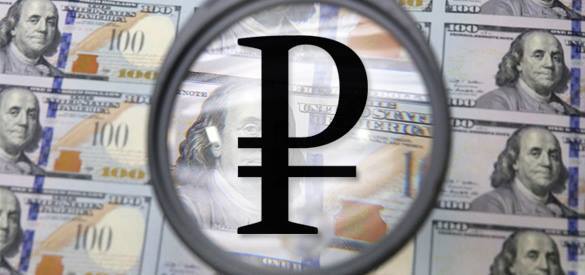Russian ruble smashed into pieces

Russia's Central Bank raised its key interest rate sharply from 10,5% to 17% on 16 December. A message posted on the website of the financial regulator says that "the decision was made due to the need to significantly restrict devaluation and inflation risks."
In the morning of December 16, playing a key rate increase, the dollar went nearly six rubles down to 58.59 rubles, and the euro slipped to 72.9 rubles, RIA Novosti reports. However, by noon of the same day, the dollar reached almost 65 rubles, the euro climbed to 81 rubles, and the ruble has thus completely lost the growth that it had showed after the Central Bank of Russia raised the key interest rate. Afterwards, the rate of the US currency went up to 69 rubles per one dollar after Brent oil dropped below the level of $60 per barrel.
The decision from the Central Bank was a reaction to the events of "Black Monday," when, on December 15, the ruble fell by almost ten percent in one day. Until that day, the Russian ruble was second only to the Ukrainian hryvnia in terms of the devaluation pace. Since the beginning of 2014, the ruble has lost about 40% of its value in dollar terms, while the hryvnia - 46%.
Some experts believe that the decision of the Russian Central Bank symbolizes the move to rescue the financial system of the country to the detriment of the economic growth. The first priority today is not economy per se, but the efforts that can stop the collapse of the Russian ruble.
Russia sees another "Black Monday" as ruble collapses
After the collapse on Monday, December 15, the loss of the ruble since the beginning of the year has amounted to about 48%, which made the Russian currency the leader of the world decline. Following the trading on Monday, the dollar and the euro soared up 5.3 and 6.1 rubles respectively, the Kommersant said. The Russian currency fell amid expectations of new sanctions from the US and declining oil prices.
The Russian currency market lives under the conditions of panic that spurs speculative interest on the part of investors. At the time when the ruble loses a few percent of its value daily, many banks and companies begin to profit from it, pushing their the main activities into the background.
The Bank of Russia needs to reduce lending to force banks and corporations sell currency, ex-chairman of the Bank of Russia, Chairman of the Supervisory Board of VTB Bank, Sergei Dubinin, told TASS. commenting on the fall of the ruble. "Right now, one is left to restrain ruble liquidity, to push banks, corporations and individuals, who need to spend money in rubles, towards selling foreign currency," said Dubinin.
According to him, the ruble has been "clearly oversold." "We can see the lack of foreign currency in exchange offices, which indicates that indicates enormous amount of currency that has been bought," he said. According to Dubinin, against the backdrop of the ongoing devaluation of the ruble, the balance of payments will be corrected, but imports will become so expensive that it will make purchasing from abroad pointless. "What can one spend this currency on then? Shall one expect another wave of speculations? One should not take currency risks so recklessly," said Dubinin.
Nothing can be done to stop the Russian ruble from falling
"In a short-term perspective, nothing will be able to stop the ruble from falling, unless the Central Bank decided to raise the rate to 20 percent," the chairman of the board of directors of MDM Bank, Oleg Vyugin said. Until recently, the ruble has been losing 4-5 percent of its value in a week. The Central Bank rate should set the rate on the level of 20 percent to prevent market members from playing against the ruble. However, the main problem is that "the Central Bank has printed a lot of money during the recent years, and it seems that the bank is not going to stop this policy. One needs to either take tight monetary actions or wait until imports stop. As long as there's import, one can not see the bottom, to which the ruble can fall," he said.
Commissioner for Entrepreneurs' Rights, Boris Titov, believes that rescuing the ruble to the detriment of economic development is not reasonable at all.
"Production becomes a big question in such circumstances... In President's recent Address to the Federal Assembly, we all heard him speaking about the need to develop business, new technologies, investment and import substitution, then the decision of the Central Bank is strongly against it," said Titov on Kommersant FM radio.
"The rate of the Central Bank means that the refinancing of commercial banks is conducted under 17% per annum. Therefore, all business plans will have to include this burden on the cost price. Every year, one will have to return 17 percent of investment resources to banks. The percentage can be even higher, as banks will take their margins. In fact, the real rate today is higher than 20%. Therefore, any project should be 20% more competitive than, for example, imports," says Titov.
Meanwhile, Russian banks already start ordering five-digit electronic displays for exchange offices. The first orders for the new displays arrived from the banks that work with foreign exchange retail, the Izvestia wrote. The currently used four-digit displays will not be able to display foreign currency rates higher than 99.99 rubles. A five-digit display contains three digits before the decimal point and two after.
The ruble has been falling so fast that Russian sellers start revisiting the practice from the 1990s, setting prices in a foreign currency equivalent, i.e. a conventional unit, known in Russia as y.e. Formally, this is prohibited under amendments to the Law on Consumer Protection from 2004, but the rapid devaluation of the ruble forces entrepreneurs to "turn back time."
Pravda.Ru
Subscribe to Pravda.Ru Telegram channel, Facebook, RSS!


